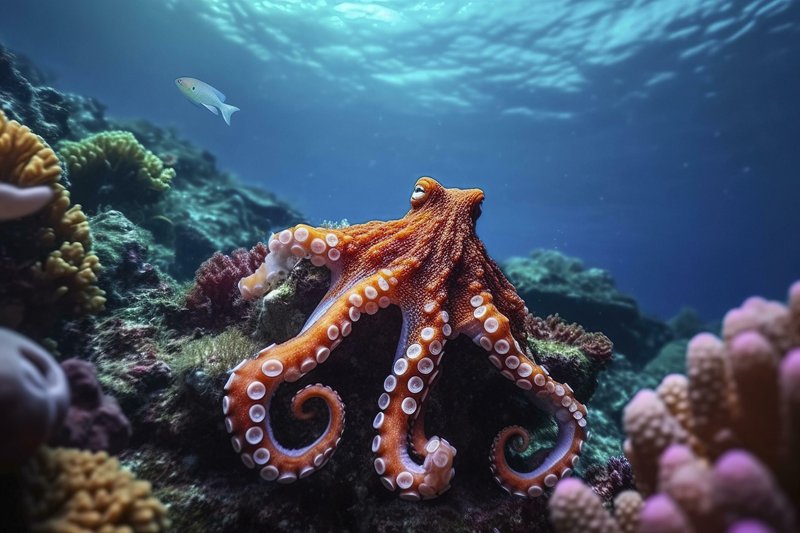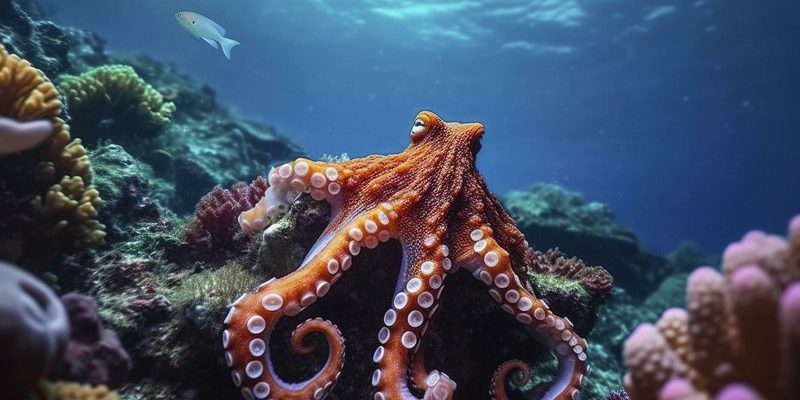
So, what makes the octopus so unique? Let’s dive deeper. From their squishy bodies to their mesmerizing colors, octopuses have developed traits that help them not just to survive, but to thrive in a world full of challenges. Whether it’s escaping from tight spots or communicating with each other, these creatures have some fascinating tricks up their sleeves—or should I say, arms?
Camouflage: Nature’s Invisible Cloak
One of the most astonishing adaptations of the octopus is its ability to blend into its surroundings. Camouflage is like a superpower for these creatures. With specialized skin cells called *chromatophores*, they can change both color and texture almost instantly. Imagine walking into a room and being able to change your outfit to match the wallpaper. That’s essentially what octopuses do!
These skin cells can expand or contract, allowing for a rapid transformation. When an octopus feels threatened or wants to sneak up on a snack, it can mimic the colors, patterns, and textures of rocks, corals, or sandy ocean floors. Honestly, it’s a mesmerizing sight to see their skin shift as they hide in plain sight. It’s not just about looking pretty; it’s a survival tactic that helps them stay safe from predators and ambush prey.
Texture Change for Perfect Disguise
Not only can octopuses change colors, but they can also alter the texture of their skin. Have you ever touched something rough and wondered how it feels different from something smooth? Octopuses can control their skin’s surface to make it bumpy, smooth, or spiky. This ability helps them blend in seamlessly with rocky environments or coral reefs. It’s like wearing a costume designed specifically for their surroundings!
This skill is not just for avoiding predators; it’s also a tactic for hunting. An octopus can lie in wait, changing its appearance to mimic the environment, and then swiftly strike when an unsuspecting fish comes too close. Talk about a stealthy strategy!
Arm Intelligence: More Than Just Limbs
Octopuses have eight arms, each equipped with thousands of sensory cells. These arms are not merely for movement; they are incredibly intelligent appendages. You might be wondering how arms can be “smart.” Well, let me explain. Each arm can independently taste, touch, and sense its surroundings.
Think of it like having multiple hands, each able to interact with the environment while the brain is busy elsewhere. This means an octopus can explore its habitat while also multitasking—catching prey or escaping danger. It’s a bit like having a group of friends helping you out during a tricky group project; everyone is working together toward a common goal.
Problem Solving and Learning
An octopus can not only use its arms well, but they are also quite good at problem-solving. Studies have shown that octopuses can navigate mazes and even unscrew jar lids to access food. This ability indicates a level of intelligence that’s quite impressive. Imagine teaching your dog to fetch a ball. Now, picture an octopus figuring out how to unlock a treat. It highlights their adaptability and cleverness.
They learn from experience, adapting their behavior based on what works and what doesn’t. This keen ability to learn through trial and error is essential for their survival in the unpredictable underwater world.
Jet Propulsion: Speedy Getaways
When it comes to escaping threats or chasing down prey, octopuses have a unique trick up their sleeve: jet propulsion. Octopuses can take in water, then expel it forcefully through a siphon. Think of it as having your personal turbo engine. This allows them to zip away in a flash when danger strikes.
It’s not just about speed; it’s also about control. They can adjust the direction and force of their propulsion, enabling them to make sharp turns or quick escapes. Imagine trying to run away from something scary, but you can change direction at a moment’s notice. That’s how octopuses outmaneuver their predators and navigate swiftly through their underwater homes.
Creating Clouds of Ink
In addition to jet propulsion, octopuses have another clever defense mechanism: they can release a cloud of ink. When threatened, they can squirt out a dark, ink-like substance that clouds the water. This ink serves two purposes: it obscures their escape and can confuse predators. It’s like throwing a smoke bomb and then dashing away while everyone is disoriented!
The ink isn’t just a random mix; it actually contains chemicals that can dull a predator’s sense of smell and taste. This extra element increases their chances of slipping away unscathed.
Advanced Vision: Seeing in Color
An octopus’s eyes are also adapted for life in the ocean. They possess excellent vision, able to see polarized light and possibly even color. This ability helps them spot prey, detect predators, and communicate with one another. Think of it like having a high-definition camera that can see things we can’t even imagine.
Moreover, their eyes can adjust focus quickly, allowing them to see sharp images at varying distances. This is vital when hunting in dimly-lit waters or trying to identify a potential threat lurking in the shadows. It gives them an advantage in noticing details that might go unnoticed by other creatures.
Communication Through Color
Octopuses can also communicate with each other using color changes on their skin. As mentioned earlier, their chromatophores allow them to change colors, but this isn’t just for camouflage. They can express emotions or intentions through patterns and colors, signaling to others in their vicinity. It’s a like a visual language that speaks volumes beneath the waves.
For instance, a bright pattern might indicate excitement or a readiness to mate, while darker colors might suggest aggression or stress. This form of communication is essential for social interactions and establishing dominance in their territory.
The adaptations of octopuses are a testament to nature’s ingenuity. From their incredible camouflage skills to their advanced problem-solving abilities, these creatures have mastered the art of survival in a complex environment. We’ve only scratched the surface of understanding how these fascinating animals operate. Each adaptation connects with their lifestyle, showcasing the intricate balance of life underwater.
As we continue to learn more about octopuses, it’s essential to appreciate their role in the ocean ecosystem. They are not just survivors; they are extraordinary examples of evolution at work. Next time you think about ocean life, remember the octopus and its remarkable adaptations. They truly are the masters of the deep blue!

